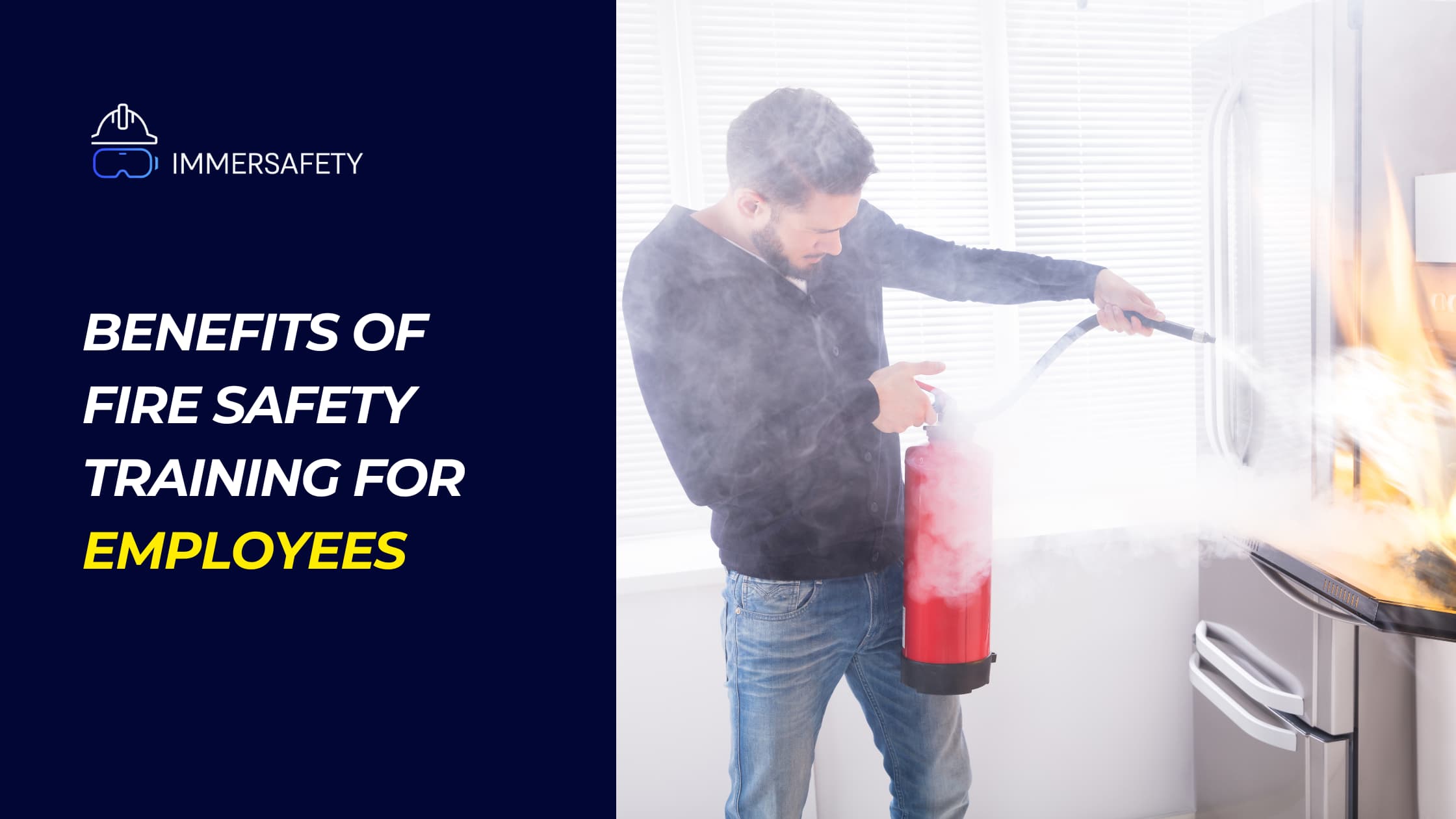Fire safety training is essential for any workplace, ensuring that employees are equipped with the knowledge and skills to act swiftly and correctly in the event of a fire.
Not only does it protect lives, but it also helps minimize property damage and promotes a safe working environment. In this blog, we will explore the key benefits of fire safety training for employees and why it is a crucial investment for businesses of all sizes.
10 Benefits of Fire Safety Training for Employees
1. Saves Lives in Emergencies
The most important benefit of fire safety training is that it equips employees with the necessary skills to react quickly and effectively in the event of a fire. Knowing how to evacuate safely, use fire extinguishers, and manage fire alarms can make a critical difference in saving lives during an emergency. Employees trained in fire safety will know exactly what to do, reducing panic and preventing confusion when every second counts.
If you want to take your fire safety next level check our – Fire extinguisher training simulator
Example: In a factory setting, fire safety training can help employees evacuate quickly, saving lives and preventing injuries during an unexpected fire drill or emergency.
2. Reduces Property Damage

Properly trained employees are more likely to take swift action in putting out small fires before they escalate into major disasters. Fire safety training teaches employees how to use fire extinguishers, stop the fire’s spread, and contain hazardous materials to prevent damage to equipment and property. By acting quickly, employees can reduce property loss and damage, ultimately saving the company significant costs.
Example: In a warehouse, employees trained in fire safety can prevent a small electrical fire from spreading, saving expensive machinery and inventory.
You’ll also like: Benefits of Fire Extinguisher Training for Employees
3. Increases Employee Confidence and Safety Awareness

Fire safety training fosters a culture of safety and responsibility among employees. When workers are confident in their ability to handle an emergency, they are more likely to feel secure in their workplace. This reduces anxiety and increases overall employee satisfaction, which can enhance productivity and morale. Employees who feel safe are more engaged and motivated to perform well.
Example: A trained employee in an office building will feel confident in knowing their emergency exits, fire extinguishers’ locations, and evacuation procedures, promoting a sense of security.
4. Complies with Legal and Insurance Requirements
In many countries and industries, fire safety training is not just a recommendation—it is a legal requirement. Employers are obligated to provide fire safety training to employees, particularly in high-risk environments such as construction sites, factories, and healthcare settings. Failing to comply with these regulations can result in hefty fines and penalties. Fire safety training ensures that companies are compliant with local regulations and can prevent costly legal issues.
Example: For a construction company, ensuring that all workers undergo fire safety training helps the business comply with Occupational Safety and Health Administration (OSHA) guidelines, avoiding potential fines.
5. Reduces Fire-Related Injuries and Fatalities
In workplaces where fire hazards are prevalent, fire safety training plays a vital role in reducing the number of fire-related injuries and fatalities. Employees are educated about the dangers of fire, how to handle combustible materials safely, and how to use fire safety equipment. By being proactive, employees can prevent dangerous accidents and injuries from occurring.
Example: In a manufacturing plant with flammable chemicals, fire safety training can significantly reduce the risk of burns, smoke inhalation, and other life-threatening injuries.
6. Promotes a Safer Work Environment
Fire safety training isn’t just about responding to fires—it’s also about preventing them in the first place. Employees are educated on safe work practices, such as handling electrical equipment, storing flammable materials, and maintaining fire suppression systems. This helps reduce the likelihood of a fire occurring, leading to a safer work environment for everyone.
Example: In an office environment, employees are trained to keep fire exits clear, avoid overloading electrical outlets, and maintain equipment, preventing fire risks.
7. Improves Emergency Preparedness and Teamwork
Fire safety training is not only about individual actions; it also teaches employees how to work together as a team during an emergency. Employees learn how to coordinate evacuations, direct others to safety, and provide first aid when necessary. This fosters a sense of collaboration and preparedness, making emergency situations more manageable and less chaotic.
Example: In a large hotel, fire safety training enables employees from different departments to work together efficiently to evacuate guests and direct them to safety during a fire drill.
8. Enhances Organizational Reputation
A company that prioritizes fire safety training demonstrates its commitment to employee welfare, safety, and legal compliance. This enhances the company’s reputation both internally and externally. A business that provides comprehensive safety training is seen as responsible and conscientious, which can attract better talent, customers, and investors.
Example: A hospital that invests in fire safety training for all staff creates an environment of trust, which enhances its reputation as a safe and well-prepared facility for both employees and patients.
9. Prepares Employees for Various Fire Scenarios
Fire safety training covers a wide range of scenarios, preparing employees for different types of fire-related emergencies. From electrical fires to kitchen fires, each scenario requires a different approach. Training programs ensure that employees are well-prepared to handle any fire emergency that may arise, making the workplace safer for everyone.
Example: In a restaurant, employees trained in fire safety can quickly handle a grease fire in the kitchen, preventing further escalation and potential destruction.
10. Saves Money in the Long Run
While investing in fire safety training may seem costly at first, the long-term benefits far outweigh the expenses. Fire safety training reduces the risk of costly fire damage, legal liabilities, and insurance claims. Moreover, businesses with a solid fire safety protocol are less likely to face costly downtime, which could affect operations and profits.
Example: A manufacturing facility that invests in fire safety training can avoid production downtime caused by fire-related incidents, saving both money and time.
FAQs
1. What is fire safety training?
Fire safety training teaches employees how to prevent, detect, and respond to fire hazards in the workplace. It covers the proper use of fire safety equipment, evacuation procedures, and emergency protocols to ensure the safety of everyone in the event of a fire.
2. Why is fire safety training important?
Fire safety training is crucial for protecting lives, reducing property damage, ensuring legal compliance, and fostering a culture of safety within the workplace. Trained employees can react quickly and appropriately during a fire emergency, which can minimize risks and prevent fatalities.
3. Who should undergo fire safety training?
All employees, regardless of their role, should undergo fire safety training. While some industries like manufacturing and healthcare may have higher fire risks, everyone should know how to evacuate safely, use fire extinguishers, and follow emergency protocols.
4. How often should fire safety training be conducted?
Fire safety training should be conducted regularly, typically once a year, to ensure that employees remain familiar with the procedures. Additionally, refresher courses can be offered after any significant changes in the workplace or fire safety regulations.
5. What does fire safety training typically include?
Fire safety training generally includes fire prevention techniques, the proper use of fire extinguishers, evacuation drills, the location of fire exits and alarms, and emergency first aid. It may also cover specific fire risks related to the workplace, such as electrical fires or chemical hazards.
Conclusion
Fire safety training is an investment that benefits both employees and businesses. It saves lives, reduces property damage, ensures legal compliance, and creates a safer work environment. By offering fire safety training, companies not only protect their workers but also safeguard their bottom line and long-term success. Investing in regular fire safety training for employees is one of the most effective ways to mitigate fire risks and ensure a secure, safe, and productive workplace.


